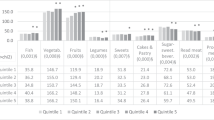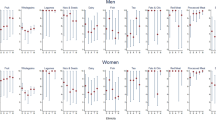Abstract
Background/Objectives:
Few studies in Europe have examined the relationship of sociodemographic and economic factors with diet in deprived populations. We analysed the association between socioeconomic characteristics and consumption of different food groups in food aid users.
Subjects/Methods:
A cross-sectional study was conducted among food aid users in four urban French zones (n=1664). Associations of sociodemographic and economic factors and food aid use with frequency of consumption of the main food groups were tested using multivariate logistic regression models accounting for sampling weights.
Results:
Both migrant status and consumption of fewer than three daily meals were associated with risk of low frequency of starchy food consumption (<3 times per day). Migrant status was also associated with low frequency of consumption of fruits and vegetables (<3.5 times per day) and dairy products (<2 times per day). Subjects with severe food insufficiency were more likely to be low consumers of fruits and vegetables, meat, seafood and eggs (<1 time per day), and dairy products. A low monthly food budget, temporary housing in a shelter and no source of household income were all associated with risk of low frequency of seafood consumption (<2 times per week). Finally, duration of food aid use, type of food aid distribution and perception of poor health status were associated with low consumption of meat, seafood and eggs.
Conclusions:
Economic level and other social characteristics were associated with an unhealthy diet within this deprived French population.
This is a preview of subscription content, access via your institution
Access options
Subscribe to this journal
Receive 12 print issues and online access
$259.00 per year
only $21.58 per issue
Buy this article
- Purchase on Springer Link
- Instant access to full article PDF
Prices may be subject to local taxes which are calculated during checkout
Similar content being viewed by others
References
Alaimo K, Briefel RR, Frongillo EA, Olson CM (1998). Food insufficiency exists in the United States: results from the third National Health and Nutrition Examination Survey (NHANES III). Am J Public Health 88, 419–426.
Bellin-Lestienne C, Deschamps V, Noukpoapé A, Darmon N, Hercberg S, Castetbon K (2006). Food consumption and position of food aid among participants of the ABENA study, 2004–2005. Bull Epidemiol Hebd 11–12, 79–81.
Bhargava A (2004). Socio-economic and behavioural factors are predictors of food use in the National Food Stamp Program Survey. Br J Nutr 92, 497–506.
Castetbon K, Vernay M, Malon A, Salanave B, Deschamps V, Roudier C et al. (2009). Dietary intake, physical activity and nutritional status in adults: the French nutrition and health survey (ENNS, 2006–2007). Br J Nutr 102, 733–743.
Charles MA, Eschwege E, Basdevant A (2008). Monitoring the obesity epidemic in France: The Obepi Surveys 1997–2006. Obesity 16, 2182–2186.
Cristofar SP, Basiotis PP (1992). Dietary intakes and selected characteristics of women ages 19–50 years and their children ages 1–5 years by reported perception of food sufficiency. J Nutr Educ 24, 53–58.
Darmon N, Andrieu E, Bellin-Lestienne C, Dauphin AG, Castetbon K (2008). The E3A survey: nutritional quality of food aid programs in France and how they work. Cah Nutr Diet 43, 243–250.
Darmon N, Drewnowski A (2008). Does social class predict diet quality? Am J Clin Nutr 87, 1107–1117.
Darmon N, Khlat M (2001). An overview of the health status of migrants in France, in relation to their dietary practices. Public Health Nutr 4, 163–172.
Dixon LB, Winkleby MA, Radimer KL (2001). Dietary intakes and serum nutrients differ between adults from food-insufficient and food-sufficient families: Third National Health and Nutrition Examination Survey, 1988–1994. J Nutr 131, 1232–1246.
Hercberg S, Chat-Yung S, Chauliac M (2008). The French National Nutrition and Health Program: 2001–2006–2010. Int J Public Health 53, 68–77.
Irala-Estevez JD, Groth M, Johansson L, Oltersdorf U, Prattala R, Martinez-Gonzalez MA (2000). A systematic review of socio-economic differences in food habits in Europe: consumption of fruit and vegetables. Eur J Clin Nutr 54, 706–714.
Kesse-Guyot E, Bertrais S, Peneau S, Estaquio C, Dauchet L, Vergnaud AC et al. (2008). Dietary patterns and their sociodemographic and behavioural correlates in French middle-aged adults from the SU.VI.MAX cohort. Eur J Clin Nutr 63, 521–528.
Lallukka T, Laaksonen M, Rahkonen O, Roos E, Lahelma E (2007). Multiple socio-economic circumstances and healthy food habits. Eur J Clin Nutr 61, 701–710.
Maillot M, Darmon N, Darmon M, Lafay L, Drewnowski A (2007). Nutrient-dense food groups have high energy costs: an econometric approach to nutrient profiling. J Nutr 137, 1815–1820.
Mejean C, Traissac P, Eymard-Duvernay S, Delpeuch F, Maire B (2008). Influence of acculturation among Tunisian migrants in France and their past/present exposure to the home country on diet and physical activity. Public Health Nutr 12, 832–841.
Mejean C, Traissac P, Eymard-Duvernay S, El Ati J, Delpeuch F, Maire B (2007). Diet quality of North African migrants in France partly explains their lower prevalence of diet-related chronic conditions relative to their native French peers. J Nutr 137, 2106–2113.
Nelson M, Erens B, Bates B, Church S, Boshier T . Low Income Diet Nutrition Survey. Summary of Key Findings. Food Standards Agency: London, 2007.
Neuhouser ML, Thompson B, Coronado GD, Solomon CC (2004). Higher fat intake and lower fruit and vegetables intakes are associated with greater acculturation among Mexicans living in Washington State. J Am Diet Assoc 104, 51–57.
Oldewage-Theron WH, Dicks EG, Napier CE (2006). Poverty, household food insecurity and nutrition: coping strategies in an informal settlement in the Vaal Triangle, South Africa. Public Health 120, 795–804.
Perrin AE, Simon C, Hedelin G, Arveiler D, Schaffer P, Schlienger JL (2002). Ten-year trends of dietary intake in a middle-aged French population: relationship with educational level. Eur J Clin Nutr 56, 393–401.
Radimer KL, Radimer KL (2002). Measurement of household food security in the USA and other industrialised countries. Public Health Nutr 5, 859–864.
Rose D (1999). Economic determinants and dietary consequences of food insecurity in the United States. J Nutr 129, 517S–520S.
Sanchez-Villegas A, Delgado-Rodriguez M, Martinez-Gonzalez MA, Irala-Estevez J (2003). Gender, age, socio-demographic and lifestyle factors associated with major dietary patterns in the Spanish Project SUN (Seguimiento Universidad de Navarra). Eur J Clin Nutr 57, 285–292.
Sharkey JR (2008). Diet and health outcomes in vulnerable populations. Ann N Y Acad Sci 1136, 210–217.
Siefert K, Heflin CM, Corcoran ME, Williams DR (2004). Food insufficiency and physical and mental health in a longitudinal survey of welfare recipients. J Health Soc Behav 45, 171–186.
Tarasuk VS (2001). Household food insecurity with hunger is associated with women's food intakes, health and household circumstances. J Nutr 131, 2670–2676.
Townsend MS, Peerson J, Love B, Achterberg C, Murphy SP (2001). Food insecurity is positively related to overweight in women. J Nutr 131, 1738–1745.
Vozoris NT, Tarasuk VS (2003). Household food insufficiency is associated with poorer health. J Nutr 133, 120–126.
Willett WC . Nutritional Epidemiology, 2nd edn. Oxford University Press: New York, NY, 1998.
Acknowledgements
We thank French associations involved in food aid for their kind cooperation. We are grateful to the Social Security Health Examination Centres and their laboratories in Bobigny, Paris, Dijon and Marseille, the ‘Département de Biologie intégrée’ at Grenoble University Hospital and the ‘Unité Neuromédiateurs et Vitamines’ at Dijon University Hospital for their contribution to data collection. This study was supported by the Institut de Veille Sanitaire (InVS), France.
Author information
Authors and Affiliations
Corresponding author
Rights and permissions
About this article
Cite this article
Méjean, C., Deschamps, V., Bellin-Lestienne, C. et al. Associations of socioeconomic factors with inadequate dietary intake in food aid users in France (The ABENA study 2004–2005). Eur J Clin Nutr 64, 374–382 (2010). https://doi.org/10.1038/ejcn.2009.153
Received:
Revised:
Accepted:
Published:
Issue Date:
DOI: https://doi.org/10.1038/ejcn.2009.153
Keywords
This article is cited by
-
Associations of fruit & vegetable intake and physical activity with poor self-rated health among Chinese older adults
BMC Geriatrics (2022)
-
Dutch food bank recipients have poorer dietary intakes than the general and low-socioeconomic status Dutch adult population
European Journal of Nutrition (2018)
-
An explorative cross-sectional study examining self-reported health and nutritional status of disadvantaged people using food banks in Germany
International Journal for Equity in Health (2015)
-
Prevalence and socioeconomic and geographical inequalities of household food insecurity in the Paris region, France, 2010
BMC Public Health (2013)
-
Impact of fruit and vegetable vouchers and dietary advice on fruit and vegetable intake in a low-income population
European Journal of Clinical Nutrition (2012)



